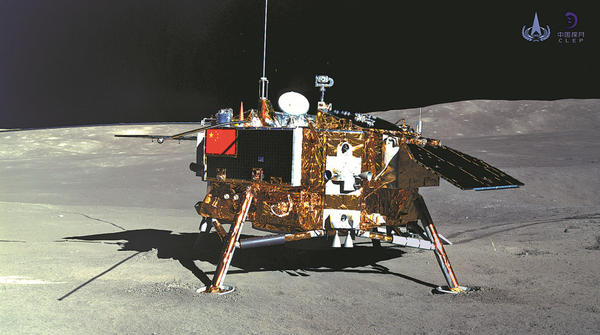China's Innovation Persistence Pays off with Great Human Progress

Photo taken by the rover Yutu 2 (Jade Rabbit-2) on Jan 11, 2019 shows the lander of the Chang'e 4 probe. [Photo/Xinhua/China National Space Administration]
BEIJING -- Chen Luojing, a designer with the China Academy of Space Technology, was surprised at the public's enthusiasm for the country's space programs.
In a display during the 19th China National Science and Technology Week in May, an event to popularize science, throngs of visitors came to watch the model of lunar rover Yutu 2, which was developed by Chen's academy.
"They were very interested in how Yutu 2 works on the far side of the moon. One visitor even asked me how the Queqiao relay satellite sets the communication link between Earth and the probe," Chen recalled.
China has made great progress in science and technology in recent years, from probing space to exploring the deep sea, and from observing the universe to researching micro particles. Advances have fueled the public zeal for science.
Over 310 million visits were paid to more than 21,000 science popularization events during the week. "It is inspiring to learn about new technologies so closely," said a visiting middle school student.
Yutu 2 has driven more than 200 meters on the far side of the moon to conduct research.
The rover was reported to have found materials from deep inside the moon that could help unravel the mystery of the lunar mantle composition. The research has been published online by the academic journal Nature.
China launched the Chang'e 4 probe on Dec 8, 2018. Its lander and Yutu 2 made the first-ever soft-landing on the far side of the moon on Jan 3.
Since the launch of its first satellite in 1970, China has achieved one feat after another in space.
In 2003, China's first astronaut Yang Liwei went into space on the Shenzhou V craft. So far, the country has launched two space labs into orbit. Tiangong 2, the second, accommodated two astronauts for 30 days and hosted a series of cutting-edge science experiments, such as quantum key distribution, a cold atomic clock and gamma ray burst observation.
Now China is building its own space station, which is expected to be operational around 2022. To lay the groundwork for its construction, China will carry out joint tests and exercises by the end of this year to prepare for the maiden flight of the Long March 5B, according to the China Aerospace Science and Technology Corporation.
China also has a busy schedule for other space activities. It will send more than 50 craft into space via over 30 launches this year, including the launch of the Long March 5 carrier rocket and the Chang'e 5 lunar probe.
